Study on Performance of Rooftop Solar Power Generation Combined with Battery Storage at Office Building in Northeast Region, Vietnam
Abstract
:1. Introduction
2. Grid-tied Rooftop Solar Power Technologies
2.1. Grid-tied Rooftop Solar Power without Battery Storage
2.2. Grid-Tied Rooftop Solar Power with Battery Storage
3. Methodology
4. Site Selection
4.1. Solar Energy Potential
4.2. Location
4.3. The Experimental Rooftop Solar Power System with Battery Storage of Case Study
5. Results and Discussion
5.1. Technical Result
5.2. Financial Efficiency Calculation
6. Conclusions
Author Contributions
Funding
Institutional Review Board Statement
Informed Consent Statement
Data Availability Statement
Acknowledgments
Conflicts of Interest
References
- Gielen, D.; Boshell, F.; Saygin, D.; Bazilian, M.D.; Wagner, N.; Gorini, R. The role of renewable energy in the global energy transformation. Energy Strategy Rev. 2019, 24, 38–50. [Google Scholar] [CrossRef]
- REN21. Advancing the Global Renewable Energy Transition. 2018. Available online: https://www.ren21.net/wp-content/uploads/2019/05/GSR2018_Highlights_English.pdf (accessed on 24 August 2021).
- Wilkinson, S.; John, M.; Morrison, G. Rooftop PV and the Renewable Energy Transition; a Review of Driving Forces and Analytical Frameworks. Sustainability 2021, 13, 5613. [Google Scholar] [CrossRef]
- Breyer, C.; Bogdanov, D.; Gulagi, A.; Aghahosseini, A.; Barbosa, L.S.; Koskinen, O.; Barasa, M.; Caldera, U.; Afanasyeva, S.; Child, M.; et al. On the role of solar photovoltaics in global energy transition scenarios. Prog. Photovoltaics Res. Appl. 2017, 25, 727–745. [Google Scholar] [CrossRef]
- International Renewable Energy Agency. Future of Solar Photovoltaic—Deployment, Investment, Technology, Grid Integration and Socio-Economic Aspects. 2019. Available online: https://www.irena.org/publications/2019/Nov/Future-of-Solar-Photovoltaic (accessed on 24 August 2021).
- Wang, Q.-J.; Chen, D.; Chang, C.-P. The impact of COVID-19 on stock prices of solar enterprises: A comprehen-sive evidence based on the government response and confirmed cases. Int. J. Green Energy 2021, 18, 443–456. [Google Scholar] [CrossRef]
- Eroğlu, H. Effects of Covid-19 outbreak on environment and renewable energy sector. Environ. Dev. Sustain. 2021, 23, 4782–4790. [Google Scholar] [CrossRef]
- International Energy Agency. Snapshot of Global PV Markets 2021. 2021. Available online: https://reglobal.co/snapshot-of-global-pv-markets-2021/ (accessed on 24 August 2021).
- Gernaat, D.E.; de Boer, H.-S.; Dammeier, L.C.; van Vuuren, D.P. The role of residential rooftop photovoltaic in long-term energy and climate scenarios. Appl. Energy 2020, 279, 115705. [Google Scholar]
- Thiab, R.; Amudy, M.; Rizal, T.A. Study on Implementation of Rooftop Photovoltaic Power Plant as an Effort to Attain a Sustainable Campus. Eur. J. Eng. Res. Sci. 2019, 4, 21–25. [Google Scholar] [CrossRef]
- Yoomak, S.; Patcharoen, T.; Ngaopitakkul, A. Performance and Economic Evaluation of Solar Rooftop Systems in Different Regions of Thailand. Sustainability 2019, 11, 6647. [Google Scholar] [CrossRef] [Green Version]
- Bendary, A.; Abdelaziz, A.; Ismail, M.; Mahmoud, K.; Lehtonen, M.; Darwish, M. Proposed ANFIS Based Approach for Fault Tracking, Detection, Clearing and Rearrangement for Photovoltaic System. Sensors 2021, 21, 2269. [Google Scholar] [CrossRef] [PubMed]
- Han, J.; Lu, L.; Peng, J.; Yang, H. Performance of ventilated double-sided PV façade compared with conven-tional clear glass façade. Energy Build. 2013, 56, 204–209. [Google Scholar] [CrossRef]
- Kotak, Y.; Gago, E.J.; Mohanty, P.; Muneer, T. Installation of rooftop solar PV modules and their impact on building cooling load. Build. Serv. Eng. Res. Technol. 2014, 35, 613–633. [Google Scholar] [CrossRef] [Green Version]
- Emara, D.; Ezzat, M.; Abdelaziz, A.; Mahmoud, K.; Lehtonen, M.; Darwish, M. Novel Control Strategy for Enhancing Microgrid Operation Connected to Photovoltaic Generation and Energy Storage Systems. Electronics 2021, 10, 1261. [Google Scholar] [CrossRef]
- Alqahtani, N.; Balta-Ozkan, N. Assessment of Rooftop Solar Power Generation to Meet Residential Loads in the City of Ne-om, Saudi Arabia. Energies 2021, 14, 3805. [Google Scholar] [CrossRef]
- Puranen, P.; Kosonen, A.; Ahola, J. Techno-economic viability of energy storage concepts combined with a residen-tial solar photovoltaic system: A case study from Finland. Appl. Energy 2021, 298, 117199. [Google Scholar] [CrossRef]
- Sanseverino, E.R.; Thuy, H.L.T.; Pham, M.-H.; Di Silvestre, M.L.; Nguyen Quang, N.; Favuzza, S. Review of Potential and Actual Penetration of Solar Power in Vietnam. Energies 2020, 13, 2529. [Google Scholar] [CrossRef]
- Prime Minister of Vietnam. Decision No: 11 /2017/QD-TTg on the Support Mechanisms for the Development of Solar Power Projects in Vietnam. 2017. Available online: https://policy.asiapacificenergy.org/node/3446 (accessed on 26 August 2021).
- Prime Minister of Vietnam. Decision 13/2020/QD-TTg on Mechanisms to Promote the Development of Solar Power Projects in Viet Nam. 2020. Available online: https://policy.asiapacificenergy.org/node/4056 (accessed on 26 August 2021).
- Available online: https://solar.evn.com.vn/#/ (accessed on 26 August 2021).
- Phap, V.M.; Huong, N.T.T.; Hanh, P.H.; Duy, P.V.; Binh, D.V. Assessment of rooftop solar power technical potential in Ha-noi city, Vietnam. J. Build. Eng. 2020, 32, 101528. [Google Scholar] [CrossRef]
- Phap, V.; Nga, N. Feasibility Study of Rooftop Photovoltaic Power System for A Research Institute towards Green Building in Vietnam. EAI Endorsed Trans. Energy Web 2018, 26, 1–9. [Google Scholar] [CrossRef] [Green Version]
- Nguyen, T.B.; Van, P.H. Design, Simulation and Economic Analysis of a Rooftop Solar PV System in Vi-etnam. Endorsed Trans. Energy Web 2021, 35, 1–12. [Google Scholar]
- Lan, T.; Jirakiattikul, S.; Chowdhury, M.; Ali, D.; Niem, L.; Techato, K. The Effect of Retail Electricity Price Levels on the FI Values of Smart-Grid Rooftop Solar Power Systems: A Case Study in the Central Highlands of Vietnam. Sustainability 2020, 12, 9209. [Google Scholar] [CrossRef]
- Van Tan, T.; Cao, L.T. Evaluating the rooftop solar photovoltaic potential in Hau Giang province. J. Sol. Energy Res. 2021, 6, 751–760. [Google Scholar]
- Le Nguyen, L.D.; Ngoc, S.D.; Cong, D.T.; Le Thuong, D.; Van, S.N.; Minh, V.N.H.; Le, N.T. Facade Integrated Photovoltaic Systems: Potential Applications for Commercial Building in Vietnam. In Proceedings of the 2019 International Conference on System Science and Engineering (ICSSE), Dong Hoi, Vietnam, 20–21 July 2019; IEEE: Piscataway, NJ, USA; pp. 219–223. [Google Scholar]
- Available online: https://en.evn.com.vn/d6/news/Press-release-on-rooftop-solar-PV-development-after-31-December-2020-66-142-2111.aspx (accessed on 26 August 2021).
- Minister of Natural Resources Canada. Clean Energy Project Analysis: RETScreen® Engineering & Cases Textbook, 3rd ed.; Minister of Natural Resources Canada: Ottawa, ON, Canada, 2005.
- Huyen, C.T.; Phap, V.M.; Nga, N.T. Study on Performance and Economic Efficiency of Solar Power on Agricultural Land: A case study in Central Region, Vietnam. Int. J. Renew. Energy Research 2021, 11, 842–850. [Google Scholar]
- D’Adamo, I.; de Monte, F.; Ferella, F.; Gastaldi, M. The case study of a photovoltaic plant located at the university of L’Aquila: An economic analysis. J. Clean. Prod. 2021, 278, 123561. [Google Scholar] [CrossRef]
- Minh, P.V.; Le Quang, S.; Pham, M.-H. Technical Economic Analysis of Photovoltaic-Powered Electric Vehicle Charging Sta-tions under Different Solar Irradiation Conditions in Vietnam. Sustainability 2021, 13, 3528. [Google Scholar] [CrossRef]
- Vietnamese Ministry of Natural Resources and Environment. Final report on the study and development of emission factor (EF) for Vietnamese electrical grid in 2018. 2020. Available online: https://vepg.vn/knowledge_database/final-report-on-the-study-and-development-of-emission-factor-ef-for-vietnams-electrical-grid-in-2018/(accessed on 26 August 2021).
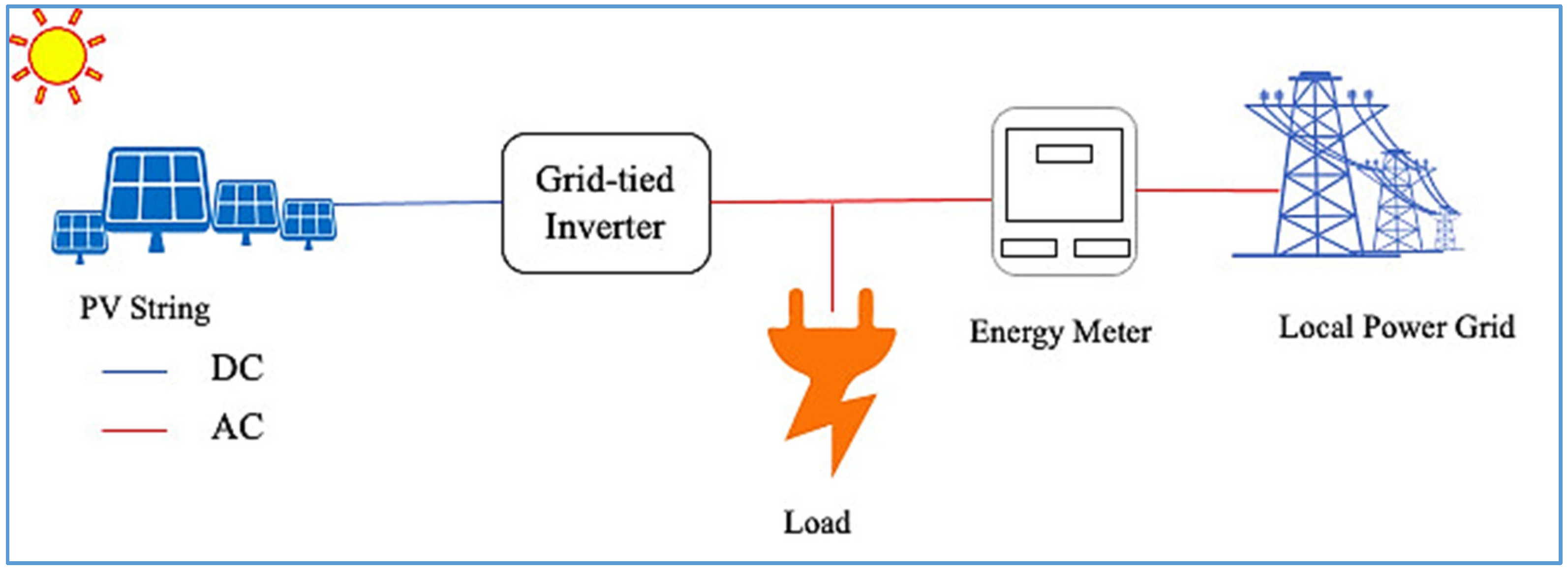
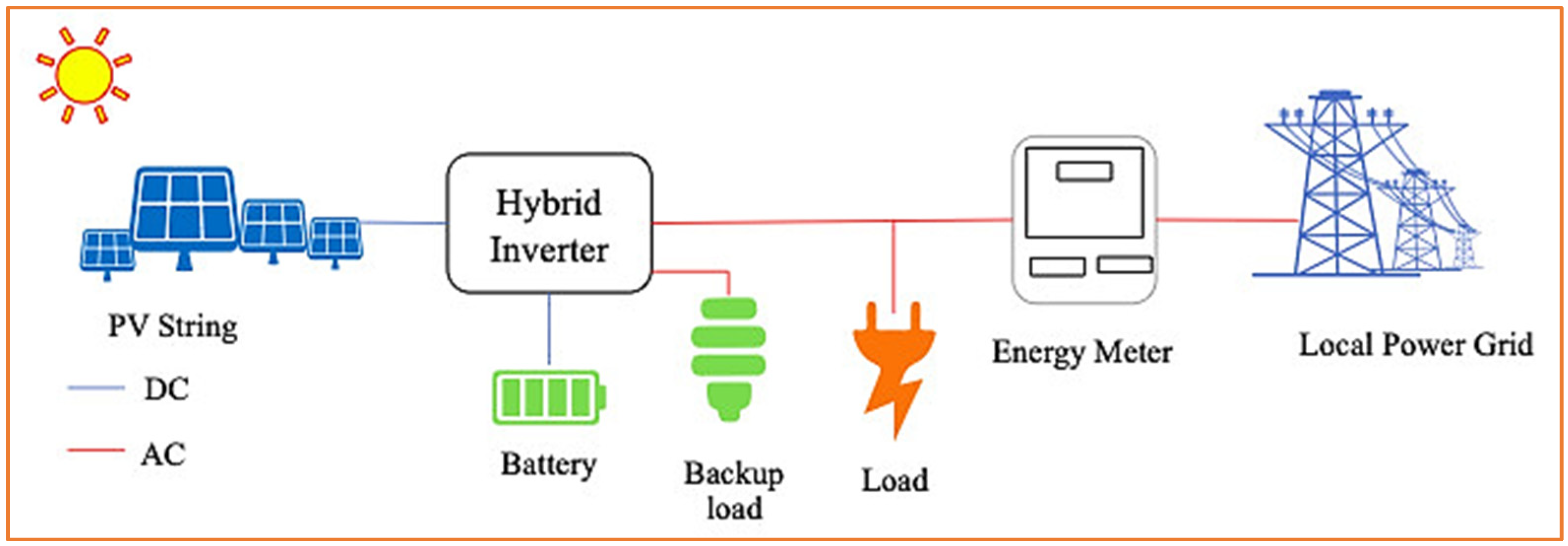
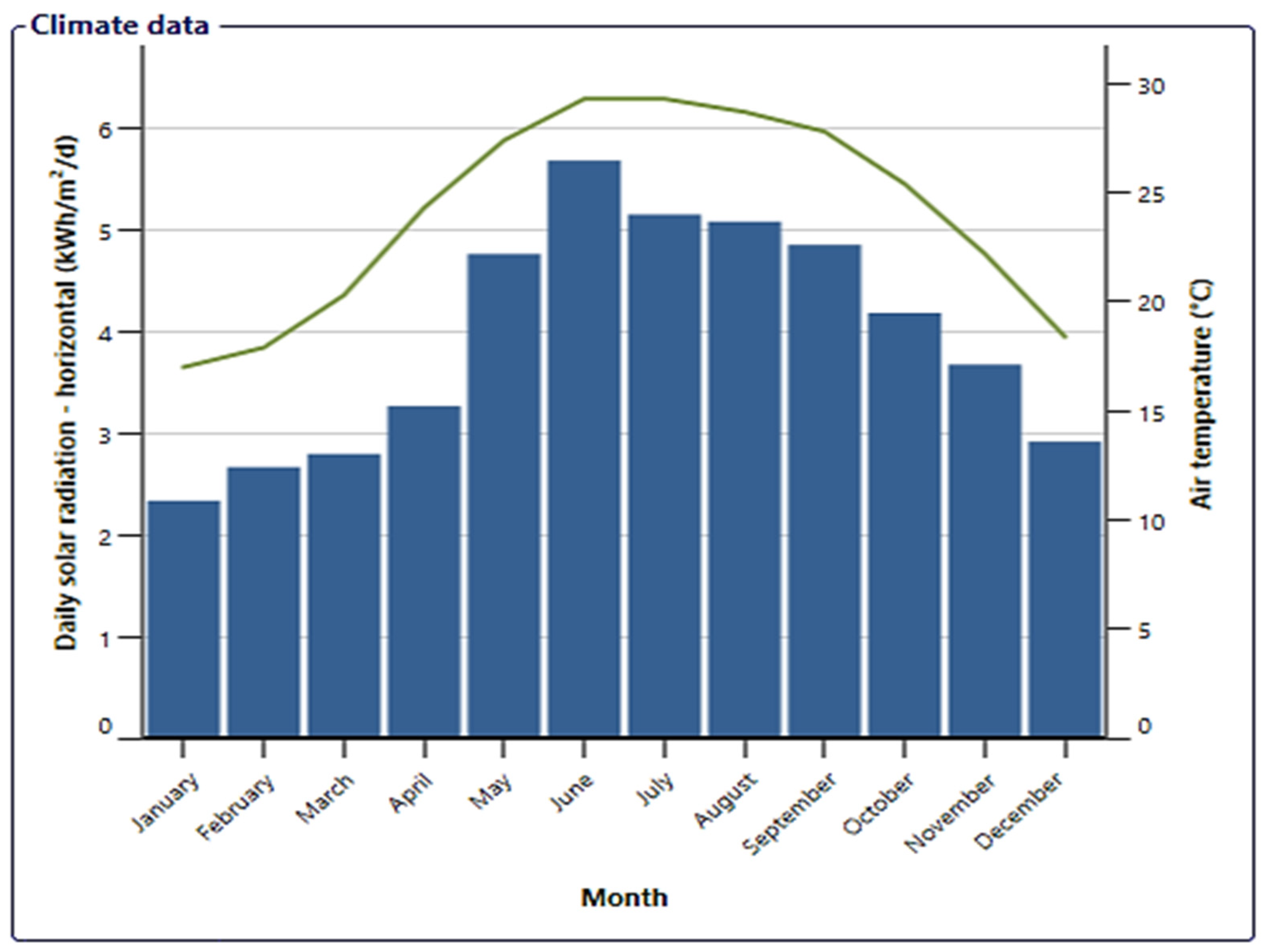

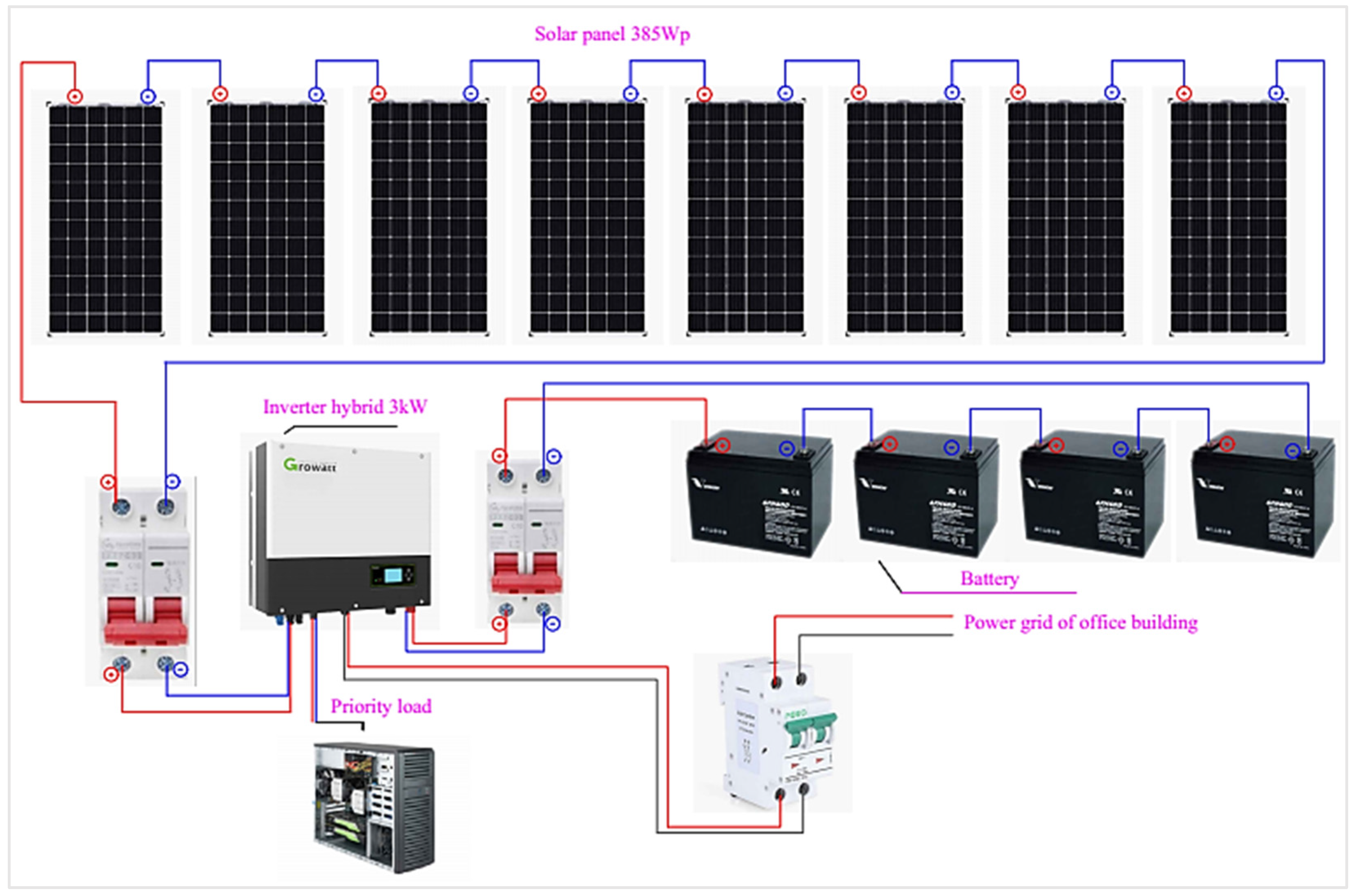

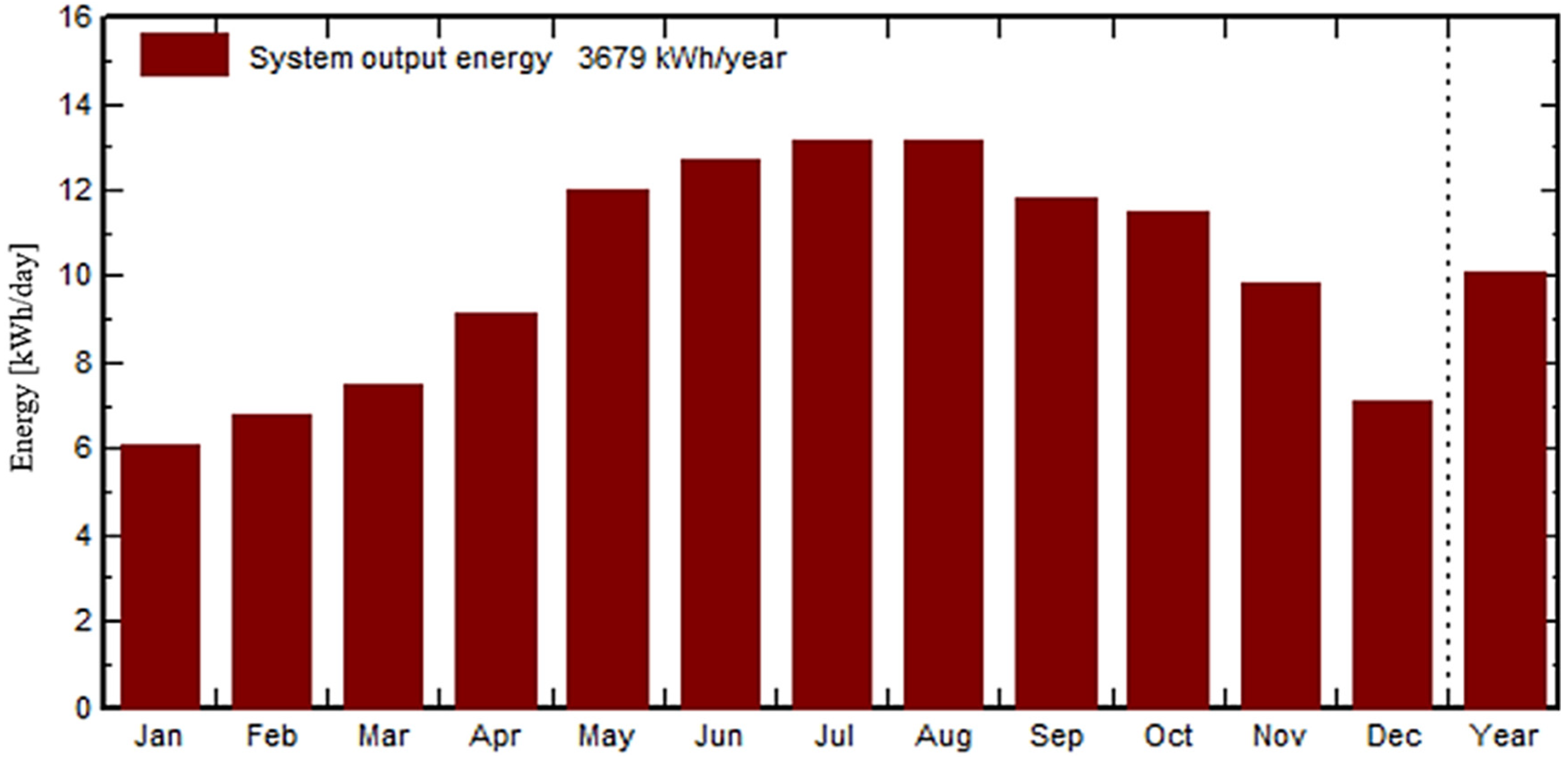





| Month | April | May | June | July |
|---|---|---|---|---|
| Simulation (kWh) | 275 | 371 | 382 | 408 |
| Experiment (kWh) | 192.7 | 337.2 | 353.2 | 378.5 |
| Difference (kWh) | 82.3 | 33.8 | 28.8 | 29.5 |
| Content | Grid-Connected Solar Power System with Storage ($) | Grid-Connected Solar Power System without Storage ($) |
|---|---|---|
| 385 Wp solar panels | 1202 | 1202 |
| 3 kW hybrid inverter | 1404 | - |
| 3 kW grid-tied Inverter | - | 429 |
| 100 Ah batteries | 870 | - |
| Mini rail array | 22 | 22 |
| Middle battery clip | 11 | 11 |
| Marginal battery clip | 3 | 3 |
| DC/AC electrical cabinets for safety current breaker, wires, jack MC4 | 343 | 343 |
| Transportation, installation, user manual, handover | 258 | 258 |
| Total cost before VAT tax | 4113 | 2268 |
| Total cost after 10% VAT tax | 4525 | 2495 |
| Specifications | Grid-Tied Rooftop Solar Power with Battery Storage | Grid-Tied Rooftop Solar Power without Battery Storage |
|---|---|---|
| Solar power station capacity (kWp) | 3 | |
| Power generation (kWh/year) | 3679 | |
| Total investment cost ($) | 4525 | 2495 |
| Total O&M cost ($) | 3060 | 1500 |
| The electricity selling price of EVN for office buildings ($/kWh) | 0.085 $/kWh and will increase by 6%/year on average | |
| Project life cycle (years) | 20 | |
| Discount rate (%) | 5 | |
| Solar panel capacity loss coefficient according to manufacturer | 2.5% in the first year and 0.7% for the following years | |
| Data | Grid-Tied Solar Power with Battery Storage | Grid-Tied Solar Power without Battery Storage |
|---|---|---|
| NPV ($) | 308 | 3402 |
| IRR (%) | 5.6 | 14.8 |
| B–C ratio | 1.1 | 2.4 |
| Payback time (year) | 13.8 | 7.6 |
| Total profit ($) | 4267 | 8032 |
Publisher’s Note: MDPI stays neutral with regard to jurisdictional claims in published maps and institutional affiliations. |
© 2021 by the authors. Licensee MDPI, Basel, Switzerland. This article is an open access article distributed under the terms and conditions of the Creative Commons Attribution (CC BY) license (https://creativecommons.org/licenses/by/4.0/).
Share and Cite
Thanh, T.N.; Minh, P.V.; Duong Trung, K.; Anh, T.D. Study on Performance of Rooftop Solar Power Generation Combined with Battery Storage at Office Building in Northeast Region, Vietnam. Sustainability 2021, 13, 11093. https://doi.org/10.3390/su131911093
Thanh TN, Minh PV, Duong Trung K, Anh TD. Study on Performance of Rooftop Solar Power Generation Combined with Battery Storage at Office Building in Northeast Region, Vietnam. Sustainability. 2021; 13(19):11093. https://doi.org/10.3390/su131911093
Chicago/Turabian StyleThanh, Tung Nguyen, Phap Vu Minh, Kien Duong Trung, and Tuan Do Anh. 2021. "Study on Performance of Rooftop Solar Power Generation Combined with Battery Storage at Office Building in Northeast Region, Vietnam" Sustainability 13, no. 19: 11093. https://doi.org/10.3390/su131911093
APA StyleThanh, T. N., Minh, P. V., Duong Trung, K., & Anh, T. D. (2021). Study on Performance of Rooftop Solar Power Generation Combined with Battery Storage at Office Building in Northeast Region, Vietnam. Sustainability, 13(19), 11093. https://doi.org/10.3390/su131911093






